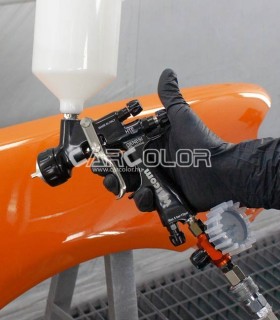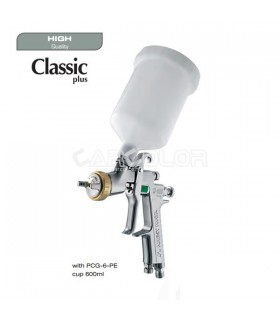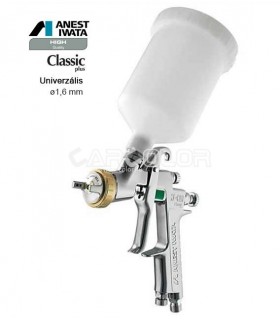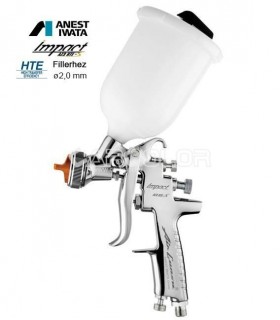Complete Guide to Spray Guns – HP, HVLP, LVLP, HTE/RP, and Modern Technologies
Spray guns are essential tools in automotive refinishing, woodworking, and a wide range of industrial surface coating applications. With the advancement of technology, professionals now have access to multiple systems, each offering different atomization principles, efficiencies, and practical advantages. The following comprehensive guide provides a detailed overview of both traditional and modern spray gun types, highlighting their benefits, drawbacks, and the most important fields of application.
In this article, we present...
Conventional (HP, High Pressure) Spray Guns
Conventional high-pressure spray guns (HP, often called conventional guns) are the oldest type of paint sprayers. They atomize paint using compressed air at high pressure, which produces an extremely fine mist and results in an exceptionally smooth surface finish.
Their advantage lies in their ability to atomize almost any material viscosity – even very thick coatings such as lacquers, adhesives, epoxies, or zinc-based primers. The higher air pressure easily breaks through dense materials, making these guns versatile for demanding applications.
However, their main drawback is extremely low transfer efficiency: only about 30–35% of the paint reaches the surface, while the rest is lost as overspray. This leads to higher paint consumption and significant paint fog, which not only raises costs but also increases environmental impact. Due to the excessive overspray, VOC emissions (volatile organic compounds released into the air) are high, making conventional systems less compliant with today’s stricter environmental regulations.
On the other hand, their simple design and lower price make them appealing in situations with limited budgets or when quick application of thick coatings (such as primers) is needed. Overall, high-pressure conventional spray guns deliver excellent surface quality and are robust workhorses, but they are wasteful, which is why more modern alternatives have been developed to replace them.
| Advantages | Disadvantages |
|---|---|
| Simple design, lower cost | Very low efficiency (30–35%) |
| Can atomize any viscosity material | High overspray, high VOC emissions |
| Robust and durable tool | Wasteful, environmentally unfriendly |
HVLP Spray Guns (High Volume, Low Pressure)
HVLP spray guns use a high volume of air (High Volume) at low pressure (Low Pressure) to atomize the paint. This combination of high airflow and low pressure creates a softer, finer spray pattern that reduces bounce-back and overspray – meaning more paint adheres to the surface and less is wasted. As a result, HVLP guns typically achieve a transfer efficiency of around 60–65%, nearly double that of conventional spray guns. This allows for more eco-friendly and cost-effective application, meeting strict air quality regulations. Since the 1990s, HVLP technology has become widely adopted in automotive refinishing and woodworking, often mandated by law to reduce VOC emissions.
The benefits of HVLP include producing a smooth, even coating. They are especially effective in automotive painting and precision work, where minimal overspray and thin, uniform layers are required. However, because of the high air volume needed, HVLP guns require a powerful compressor; they will not perform properly with a weak one. In addition, when spraying thicker, high-solids materials such as HS clear coats, HVLP guns may feel slower or “choked” compared to conventional guns. Another drawback is their sensitivity to pressure settings: small fluctuations can affect the spray pattern, sometimes leading to an orange-peel texture if not adjusted correctly. Overall, HVLP systems are material- and eco-friendly solutions, suitable for medium-scale projects like car body parts, furniture, and joinery.
Note: HVLP spray guns are available in two formats: turbine-driven units (where a separate electric turbine produces the high air volume) and conventional compressor-based designs. In automotive refinishing, compressor-based HVLP guns are the standard. Turbine HVLP units are more popular for small-scale or on-site work (such as wood restoration or fence painting), since they are portable, self-contained systems. Both types operate on the same principle – high volume, low pressure – and provide similar benefits in reducing overspray.
| Advantages | Disadvantages |
|---|---|
| 60–65% efficiency, less overspray | Requires a strong compressor |
| Environmentally friendly, VOC compliant | Slower with high-solids materials |
| Smooth, even finish | Sensitive to settings |
LVLP Spray Guns (Low Volume, Low Pressure)
LVLP spray guns can be considered advanced versions of HVLP systems, designed to operate with even lower air consumption. Their working principle is similar: atomizing paint at low pressure, but they require significantly less air than HVLP setups. This makes them highly effective with smaller or less powerful compressors, which is why LVLP is ideal for small workshops or even mobile refinishing jobs where portable compressors are used. Their air demand is only about 5–10 CFM (140–280 l/min), compared to HVLP’s 10–20+ CFM, and they usually perform well at operating pressures of 25–45 psi (1.7–3 bar).
Another advantage is their ability to deliver paint very evenly and with precise control, making them excellent for fine details, small surfaces, or repair work. LVLP guns generate minimal overspray and bounce-back, which means paint waste is kept to a minimum. Their transfer efficiency can reach 70–80%, making them even more economical than HVLP in many cases. Less paint is scattered on unwanted areas, resulting in a more eco-friendly and cost-effective process with less masking and cleanup required. Their soft spray pattern is highly appreciated by automotive painters, especially for delicate clear-coat applications or metallic/pearl finishes, where the risk of defects is minimal and an even film build is crucial. Similarly, in woodworking they are well suited for varnishing or staining furniture, where thin coats and low overspray are essential.
Limitations become apparent on larger surfaces. Because LVLP guns deliver less air and paint, covering a large car panel or wall surface can take more time than with HVLP guns. Therefore, in production environments where speed matters (such as painting complete cars in sequence), LVLP may be slower. Also, many LVLP guns do not officially meet the 65% transfer efficiency compliance level under all conditions, meaning not every model qualifies as “HVLP compliant” under the strictest regulations. Still, in places where compliance certification is not mandatory, LVLP systems are widely adopted for their cost savings and excellent spray quality.
In summary, LVLP spray guns are versatile and efficient systems that provide high-quality finishes. They are particularly recommended for detailed work, smaller objects, or beginner painters who may not have access to a high-capacity compressor.
| Advantages | Disadvantages |
|---|---|
| Low air demand, works with smaller compressors | Slower for large surfaces |
| 70–80% efficiency, very economical | Not all models are HVLP-compliant |
| Fine spray pattern, ideal for touch-ups and details | Less suitable for high-volume production work |
HTE (High Transfer Efficiency) and RP (Reduced Pressure) Systems
High Transfer Efficiency (HTE) technology was developed with the goal of achieving the highest possible paint transfer efficiency. These spray guns are considered an evolution of HVLP: they optimize the air–paint ratio, often using a slightly higher atomization pressure than traditional HVLP, but still far below that of old high-pressure guns. The result is faster and easier material application, especially when spraying thicker coatings (such as 2K high-solids clear coats), while maintaining or even exceeding the transfer efficiency of HVLP. Depending on the model, HTE spray guns can reach 70–80% efficiency, ensuring more paint reaches the target surface, with less waste and lower emissions.
Reduced Pressure (RP) is the term used by the German manufacturer SATA to describe their own version of HTE technology – essentially representing the same category. RP spray guns are optimized conventional-style guns that operate at lower air pressure, while still delivering excellent atomization and achieving over 65% transfer efficiency. The concept behind SATA RP is to combine the speed and strong atomization of conventional spray guns with the efficiency of HVLP. HTE/RP guns were specifically designed to eliminate certain disadvantages of HVLP: by working at higher pressures, they spray faster, atomize more finely (without the “choked” feeling when spraying thick coatings), and still meet or exceed 65% efficiency.
HTE technology (including RP, Trans-Tech, and other compliant designs) has been available since around 2003, when DeVilbiss developed the first such compliant spray gun. Since then, nearly all major manufacturers have introduced their own versions. Depending on the brand, names differ: SATA uses RP, DeVilbiss calls theirs Trans-Tech, and others simply label them as Compliant guns. Regardless of the name, the core principle is the same: achieving 65%+ efficiency even with high-solids coatings, thereby complying with VOC regulations.
Advantages in summary: faster spraying compared to HVLP (up to 30% quicker), finer atomization resulting in smoother, high-quality finishes, versatility (suitable for primers, basecoats, and clear coats), and lower air consumption than HVLP. For these reasons, HTE/RP guns have become widely adopted in Europe and other regions where strict environmental laws drove the transition. Today, in professional body shops, the HTE/RP spray gun is often considered the all-round choice, combining HVLP’s efficiency with the speed and spray quality of conventional guns.
Note: It is important to remember that a spray gun cannot simply be converted from HVLP to RP (or vice versa) by changing the nozzle. The difference lies in the air cap and internal design. However, some manufacturers (e.g., SATA) do offer the same gun model in both HVLP and RP versions, which look nearly identical but use different caps – often color-coded (for example, SATA marks HVLP with a green ring and RP with a blue ring).
| Advantages | Disadvantages |
|---|---|
| 65%+ efficiency, faster application | More expensive than HVLP |
| Fine atomization, less overspray | Cannot be converted from HVLP without a dedicated cap |
| Ideal for high-solids coatings | May still require a strong compressor |
LVMP Spray Guns (Low Volume, Medium Pressure)
LVMP technology, as the name suggests, uses a low volume of air but operates at medium pressure, somewhat higher than HVLP yet still lower than conventional HP guns. This makes it a hybrid solution between HVLP and traditional systems. An LVMP spray gun consumes less air than HVLP, but applies greater pressure, though not to the extreme levels of old conventional guns. The result is atomization that is finer than HVLP – approaching the high-quality atomization of conventional guns – while maintaining a transfer efficiency similar to HVLP (around 60%). In other words, LVMP guns can deliver finishes nearly as smooth as conventional guns but with reduced paint waste.
The main advantage of LVMP is its superior atomization quality, which makes it suitable for very fine finishing work. In woodworking, for example, LVMP is often used for staining, varnishing, and furniture finishing, where an even, delicate film is required. Many professionals consider it the “golden middle ground”: it provides a better finish than HVLP, while avoiding the wastefulness of traditional spray guns.
The disadvantage is that most LVMP spray guns are not officially considered compliant under strict emissions regulations, as they may not always reach the guaranteed 65% transfer efficiency. Therefore, in regions where HVLP compliance is legally required, LVMP may not be permitted. Additionally, LVMP guns usually cost more than basic HVLP or conventional models due to their more sophisticated design. This can be a barrier for smaller workshops or occasional users.
In summary, LVMP systems are most useful when outstanding surface quality is needed but providing very high airflow for HVLP is not possible, or when HVLP’s atomization is not fine enough for the task. In these cases, LVMP provides an excellent compromise: nearly conventional-level finish quality, with better paint efficiency than traditional high-pressure guns.
| Advantages | Disadvantages |
|---|---|
| Fine atomization, excellent finish quality | Not always compliant with regulations |
| Lower air consumption compared to HVLP | Higher price than HVLP or conventional guns |
| “Golden middle ground” between HVLP and HP | Not always accepted as a legal HVLP alternative |
“Trans-Tech” and Compliant Technologies (VOC Regulation-Compliant Systems)
Trans-Tech (short for transitional technology) and the more general term “compliant” describe modern spray gun systems designed to meet environmental (VOC) regulations, ensuring at least HVLP-level transfer efficiency (65% or higher). As mentioned earlier, HVLP guns do not always achieve 65% efficiency, especially with very thick coatings. Compliant spray guns were developed to solve this issue, introducing alternative atomization methods that maintain over 65% efficiency even under challenging conditions. “Trans-Tech” is the specific brand name used by DeVilbiss for their compliant technology. In practice, Trans-Tech spray guns operate with low air volume at medium pressure (similar to LVMP) to achieve higher efficiency.
The main advantage is that they combine the best of both worlds: spray patterns that are nearly as fine as those of conventional guns, while maintaining efficiency close to HVLP levels. According to industry reports, Trans-Tech guns typically achieve around 60% or better efficiency, approaching HVLP standards, but with surface finishes nearly identical to conventional guns. These guns are often used in situations where HVLP is not legally required but paint savings and efficiency remain important considerations.
The term “Compliant” (often used as a general label across brands) simply indicates that the system meets regulatory standards. Manufacturers use different names for their versions of compliant technology: RP (SATA), Trans-Tech (DeVilbiss), HTE or HTE Compliant (various brands), or sometimes just LV (for example, certain Anest Iwata models use “LV” to indicate high-efficiency low-pressure operation). While technical details differ – some designs reduce pressure, others optimize air volume or use special air caps – the goal is always the same: achieve HVLP-level or better efficiency without compromising surface quality.
In practical use, compliant spray guns such as those from IWATA and Walcom are especially popular in automotive refinishing for both basecoats and clear coats, as they deliver fast, consistent film builds with minimal overspray. They are also spreading in industrial finishing (e.g., production paint booths) and woodworking, where paint savings are equally valuable. Many compliant guns also consume less air than traditional HVLP models, making them more economical to operate. In some regions, compliant guns only became widely recognized during the 2010s, but they are now increasingly standard in the professional market thanks to their balance of efficiency, environmental compliance, and finish quality.
| Advantages | Disadvantages |
|---|---|
| VOC compliant (65%+ efficiency) | May require precise setup |
| Balanced transfer efficiency and surface quality | Price-to-value ratio varies by brand |
HTi – High Transfer Efficiency Improved / Innovative
Several manufacturers – for example, Sames Kremlin – use the abbreviation HTi to describe their advanced high-efficiency spray gun designs. The concept behind HTi is to deliver the best possible surface quality while maintaining exceptionally high transfer efficiency. For instance, Sames Kremlin’s HTi spray guns achieve at least 65% efficiency, making them fully VOC-compliant, while at the same time offering extremely fine atomization that rivals or surpasses older systems.
The name “High Transfer Efficiency Improved” highlights the fact that the standard HTE system has been enhanced, often capable of maintaining 65%+ efficiency even at very low cap pressures (around 0.7 bar). In industrial applications such as furniture finishing and general manufacturing, HTi spray guns are especially popular because they reduce material waste while producing excellent spray patterns. These features make them well-suited for high-demand environments where quality and compliance must go hand in hand.
In summary, HTi is not a separate technology category but rather a brand-specific designation used by some manufacturers for their latest-generation compliant spray guns. These models are engineered to meet the strictest environmental standards while still delivering premium finish quality and operational efficiency.
| Advantages | Disadvantages |
|---|---|
| Enhanced HTE system | Brand-specific, limited to certain manufacturers |
| Excellent efficiency even at low pressure | Higher purchase cost |
HALO – High Atomization, Low Overspray
HALO technology is a term used by the manufacturer Walcom for their proprietary high-efficiency spray system. HALO stands for High Atomization, Low Overspray. This is not a general industry category but a Walcom-specific brand name. The idea behind HALO is to achieve strong atomization at relatively low cap pressure, resulting in an exceptionally high transfer efficiency – typically around 80%. According to Walcom, these results have also been verified by independent laboratory testing, confirming the performance of the system.
In practice, HALO can be seen as a combination of HVLP and HTE: it meets strict environmental standards (65%+ efficiency) while offering the fast spraying speed and strong atomization more typical of conventional guns. Walcom has invested over 20 years of development into this system, and their new generation of Walcom Genesi Carbonio spray guns feature this HALO technology as a core design.
For example, the Walcom Genesi Carbonio 360 guns are available in HALO/HTE versions, producing an ultra-fine mist with even coverage, and delivering transfer efficiencies exceeding 80%. These spray guns are primarily intended for automotive refinishing (with dedicated models for basecoat and clearcoat applications), but they can also be used in any field where premium finish quality and minimal material waste are critical.
| Advantages | Disadvantages |
|---|---|
| 80%+ efficiency, excellent atomization | Exclusive to Walcom products |
| Premium quality, minimal overspray | Higher purchase price |
Hybrid and Digital Spray Guns (Modern Developments)
Among the latest spraying technology trends are “smart” digitally controlled spray guns and various hybrid systems. A digital spray gun generally means that a built-in electronic pressure gauge and regulator are integrated directly into the gun. In the past, painters had to use analog manometers attached to the base of the gun to set air pressure. Since 2001, when SATA introduced the first digital spray gun, this function has been available with electronic displays. Today, several manufacturers offer digital versions (such as SATAjet 5000/5500 Digital, DeVilbiss DV1 Digital, Anest Iwata LS-400 Digital). The advantage is precise pressure control, which is critical in modern multi-layer paint systems – even slight deviations can affect color shade or metallic effect.
With a digital gauge, the painter always knows the exact inlet pressure, ensuring consistent and repeatable finish quality from job to job. Built-in digital units are solvent-resistant and reliable in daily use, and by 2021, SATA celebrated the 20th anniversary of this technology, which has since become a “standard feature” in the premium category. Retrofit digital modules are also available (such as the SATA adam 2), which can be attached to any spray gun, allowing users to benefit from digital accuracy even with older models.
The term “hybrid spray gun” is used by manufacturers in different ways. In general, it refers to guns that combine multiple technologies to merge their advantages. For example, some new-generation HVLP guns are marketed as hybrids because they feature special air caps designed to maintain stable atomization under all climate conditions (such as the Anest Iwata LS-400 HVLP Hybrid). In other cases, a hybrid system may mean additional enhancements such as integrated heating elements in the air or paint path to improve atomization, effectively combining traditional and modern principles. Walcom’s Thermodry system, for instance, pre-heats the air supply, helping waterborne paints dry and atomize more effectively. Some manufacturers also integrate LED work lights onto spray guns (e.g., Walcom), providing better visibility when spraying dark colors or hard-to-reach areas. These innovations all aim to improve efficiency, accuracy, and quality control during the painting process.
Finally, it is important to highlight that spray gun technology continues to evolve, responding to the demands of automotive refinishing (VOC reduction, new paint materials) as well as industrial and woodworking applications (higher productivity, automation). The overview above covers the main categories – from traditional high-pressure guns to modern eco-friendly systems – and touches on brand-specific developments. Each technology has its strengths and weaknesses, so selecting the right spray gun always depends on the specific task, material, environment, and user needs. The key takeaway is that modern spray guns make it possible to achieve premium-quality finishes more economically and with greater environmental responsibility – whether painting car bodies, wood furniture, or industrial equipment.
Summary
The development of spray gun technology over the past decades has been largely driven by environmental regulations and the need for cost efficiency. Traditional high-pressure systems have gradually been replaced by HVLP, LVLP, HTE/RP, Trans-Tech, and other modern designs. Each system has its own place: HP guns are simple and inexpensive, HVLP and LVLP are more environmentally friendly, HTE and RP are fast and efficient, LVMP delivers very fine finishes, Trans-Tech and HTi provide compliant solutions, while HALO and digital spray guns represent the premium category. Choosing the right spray gun always depends on the specific task, the type of coating material, and the user’s requirements. Today, there is a solution available for every need – whether it is automotive refinishing, woodworking, or industrial production line applications.




























